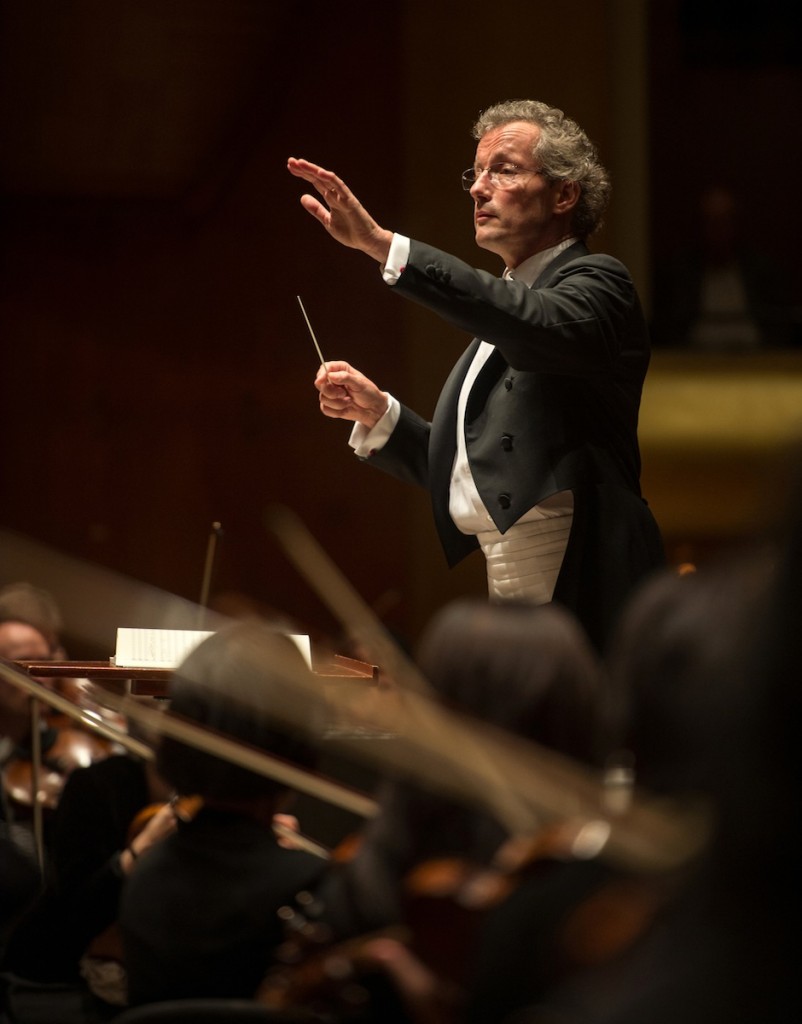Welser-Möst, Cleveland Orchestra illuminate White Light Festival with a rich and arresting “Mass in C”

Franz Welser-Möst led the Cleveland Orchestra at the White Light Festival Monday night at Avery Fisher Hall. Photo: Kevin Yatarola / Lincoln Center
On hiatus from its annual residency at Carnegie Hall this year, the Cleveland Orchestra made its first New York appearance of the season at Avery Fisher Hall on Monday, as part of the inscrutably named White Light Festival. Now in its fourth year, the festival aims to “illuminate our interior lives and highlight our shared humanity.”
Whatever we are to make of that mission statement, White Light showcased a first-rate ensemble in the Cleveland Orchestra, which presented a program of three pieces that are each puzzling in their own ways.
Olivier Messiaen’s Trois petites liturgies de la présence divine, explores different manifestations of divine presence and features the composer’s own poetry. Messiaen was outspoken about the faith that played sucha pivotal role in his music, and so it seems odd initially that a piece on this subject would be as unsettling as it is. Under the baton of Franz Welser-Möst, Cleveland’s music director, it approached “disturbing.”
The piece features an all-female chorus, and in the first part, “Antienne de la conversation intérieure,” the women of Robert Porco’s Cleveland Orchestra Chorus sang with a purity and innocence that made them sound almost like a children’s choir, softly cooing “Mon Jésus, mon silence.” Their tenderness was peppered with maddening interruptions from the piano and a feverish violin solo.
For the most part, the orchestra played with the tremendous polish and discipline that are their calling cards, though there was some shakiness in the second part of the cycle, “Séquence du Verbe, cantique divin.” Yet here they captured perfectly Messiaen’s transfixing chaos, punctuated by shimmering moments of unity.
The conclusion, “Psalmodie de l’ubiquité par Amour,” is the most disquieting part of the cycle, and includes episodes of frighteningly fanatical chanting, with moments of graceful repose emerging from the fervor. Welser-Möst’s reading was clear and considered, but narrow in scope—like many of his performances, whether cold chaos or warm tenderness, it left one wanting more.
Beethoven’s Grosse Fuge is famously an orphaned movement from String Quartet No. 13, but even out of its original context it is celebrated as one of the most revolutionary pieces in the revolutionary composer’s oeuvre. It is startlingly complex, each voice taking on a life of its own, and if the ensemble is not impeccable it can sound as though it is teetering on the brink of dissolution.
Welser-Möst had some surprising trouble keeping his troops together. He had barely mounted the podium before he gave the first downbeat, and the orchestra did not quite seem ready for it, with the first entrance a minor mess. Throughout, his interpretation suffered as he did an admirable job of keeping everyone reined in but failed to produce real muscle in the con brio sections. The meno mosso stretches showed off the dark intensity of the lower strings in spots, but mostly sat in placid contentment.
The fugue nonetheless made a striking contrast to the Mass in C Major, which made up the second half of the program. Beethoven wrote only two masses, and in this first attempt from 1807 he seems constrained or even daunted by the form so mastered by his teacher Haydn, whose influence can be heard here. To be sure, there are novel ideas in this mass, but it lacks the degree of free-spirited individualism that characterizes many pieces that Beethoven wrote around the same time or even earlier, not least the Symphony No. 5.
And yet Welser-Möst took everything Beethovenian about the piece and magnified it, drawing rich, fleshy playing from the strings and a massive sound from the chorus. The “Gloria” in particular was marvelous, ranging through an array of colors and emotions. Quiet pleas of “miserere nobis” were broken off by a bubbling, joyful cry of “quoniam tu solus sanctus.”
There were shortcomings, most of them to be found in the vocal quartet. The soprano Luba Orgonášová slid distractingly into many of her notes, and the excessively dark, covered tone of mezzo-soprano Kelley O’Connor was often difficult to hear. Meanwhile, the tenor Herbert Lippert showed a rich—if not always nimble—caramel tone and the bass-baritone Ruben Drole brought a booming, woody voice, but the two men struggled to match each other’s tuning.
Fortunately, the soloists are not so prominent in this mass as in many others, and a weak quartet can be overcome with committed performing elsewhere, of which there was plenty. The “Credo” was arrestingly rich, while the “Sanctus” began with gorgeous, reverent quiet. It was here that the quartet did their best work, singing warmly in the “Benedictus,” though still having trouble with their pitch.
The “Agnus Dei” was masterfully crafted, played with character and heft, but with plenty of room to breathe. Beethoven doesn’t include one of his trademark false endings in this piece, but Welser-Möst surprised with his resolution nonetheless: Conductors often draw out the final lines to put an extra period on them, but he allowed the piece to expire on its own, bringing it to a perfectly natural conclusion.
The White Light Festival will continue with performances of Akram Khan’s solo performance piece, “Desh,” on November 6 and 7. whitelightfestival.org
Eric C. Simpson is the Hilton Kramer Fellow in Criticism at The New Criterion
Posted Nov 06, 2013 at 12:28 pm by Charles Michener
When I heard the same fascinating program in Cleveland last week, I was slightly disappointed that the words – or at least the sense of the French words – felt relegated to the background in the Messiaen, sacrificed for the instrumental brilliance of the music. Was this the case at Avery Fisher Hall?